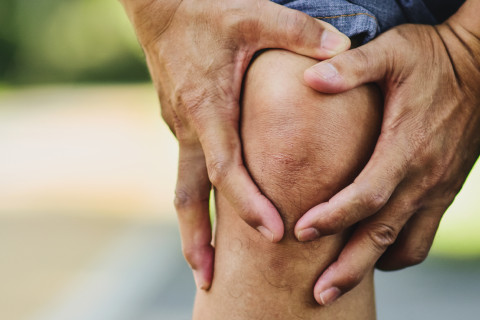Soili Törmälehto’s doctoral thesis from the University of Eastern Finland shows that knee osteoarthritis (OA) was associated with clinically significantly lower health-related quality of life (HRQoL) scores, but pain experience and depressive symptoms had a greater effect on HRQoL than radiographic findings alone. HRQoL of most people who had knee OA or an increased risk of knee OA remained unchanged over an eight-year trajectory. Worsening of quality of life was associated with several risk factors, and it also reflected the patient's need for treatment.
The study observed that by taking pain experience into account, HRQoL can be assessed more reliably than with radiographic findings alone. In addition to pain, other factors were found to associate with lower HRQoL scores, i.e. severe radiographic knee OA and depressive symptoms. Furthermore, different radiographic and symptomatic definitions of knee OA were associated with different HRQoL indices.
It was observed that the HRQoL trajectory in persons with knee OA varied between patient subgroups. Four HRQoL trajectory groups could be identified. 63% of study participants belonged in the ‘no change’ group that experienced no worsening in their HRQoL. HRQoL worsened ‘slowly’ in 17% of the study participants and ‘rapidly’ in 10%, while 10% experienced their HRQoL as ‘improving’ after initial decline. Female sex, higher body mass index, smoking, knee pain and lower income at baseline were associated with rapidly worsening HRQoL. Furthermore, the patient’s subjective experience of HRQoL reflected their need for treatment; The use of pain medications was lowest in the ‘no change’ group, and knee replacement was more common in the ‘rapidly worsening’ group.
OA, often affecting the knee joints, is the most common type of arthritis. While the root cause of OA remains unknown, ageing, obesity, and joint injuries as well as joint stress and family history have been found to be major risk factors. For patients, joint pain, joint stiffness, and activity limitations are major consequences of OA. Knee OA impairs the ability to work and exercise, and exposes the elderly to falls and fractures. It is estimated that knee OA affects almost 10% of individuals aged 55–64 years in Finland, and in older age groups the prevalence is even higher. The societal burden consists of different costs, for example, joint replacement surgeries, sickness benefits, and disability pensions. Knee OA is the cause of 94% of knee replacements in Finland, resulting in about 12,700 surgeries per year. Due to knee OA, 41,000 clients per year visit primary health care physicians. Furthermore, approximately 3.5% (29 million €) of sickness benefits are due to knee OA, and approximately 4% of disability pensions are granted for the same reason in Finland.
The diagnosis of knee OA is based on the radiographic findings, signs and symptoms. The definition of knee OA depends on the criteria and the classification system used. The radiographic changes in knee joint are related to the symptoms, but not as strongly as one might expect, and patients with radiographic findings may be asymptomatic and vice versa. There are also numerous instruments which can be utilized to assess HRQoL, but there is no universally applicable tool. Instead, the choice of instrument depends on its use: generic, disease-specific, and preference-based instruments have their own distinct uses. However, studies on HRQoL related to knee OA have applied different types of HRQoL instruments and different knee OA definitions, for example either radiographic or symptomatic, and these choices can have an impact on subsequent health economic evaluations. In addition, previous studies have observed different patient subgroups in terms of knee pain and function. The aim of the doctoral thesis was to investigate the preference-based HRQoL indices of persons with knee OA or at increased risk of developing knee OA, in relation to the different knee OA definitions. Another aim was to identify patient subgroups with similar change patterns in their disease-specific HRQoL scores. A secondary aim was to explore the associations between patient-specific factors and HRQoL scores.
HRQoL refers to the subjective experience of one’s health and well-being and the aspects of life that are affected by the health state. In the case of chronic diseases such as knee OA, measuring the patient’s HRQoL can provide valuable information on the effectiveness of different treatments in addition to traditional objective indicators such as hospital days. HRQoL measures can be used to assess the timeliness of care and as a quality indicator of treatment as well as to support the health care decision-making.
Data used in the study were obtained from the Osteoarthritis Initiative (OAI) database, which is a US longitudinal cohort study following the progression and incidence of knee OA over eight years in persons with knee OA or at increased risk of developing knee OA. The present study included 4,733 persons without knee replacement at baseline. In the thesis, the HRQoL instruments applied were either the generic preference-based SF-6D (Short Form Six-Dimension health index) or the disease-specific KOOS QoL (Quality of Life subscale of the Knee injury and Osteoarthritis Outcome Score). Different radiographic and symptomatic knee OA definitions were tested: both radiographic definition with severity classification (K-L, Kellgren-Lawrence grade) and symptomatic definition taking into account the patient’s pain experience in accordance with radiographic findings. The study used group-based trajectory modelling to identify patient subgroups with similar change patterns in their HRQoL.
These observations can help to identify patients with knee OA who are at risk of worsening quality of life and who would most benefit from early treatment. The findings can also provide insights for health economic evaluations related to knee OA.
The doctoral dissertation of Soili Törmälehto, MSc (Pharm) and MSc (Econ), entitled Health-related quality of life in persons with knee osteoarthritis: Osteoarthritis Initiative (OAI) study, will be examined at the Faculty of Health Sciences. The Opponent in the public examination will be Docent Antti Eskelinen of Tampere University, and the Custos will be Professor Janne Martikainen of the University of Eastern Finland. The public examination will be held in Finnish on 6 November 2020.
Photo available for download at https://mediabank.uef.fi/A/UEF+Media+Bank/37910?encoding=UTF-8



